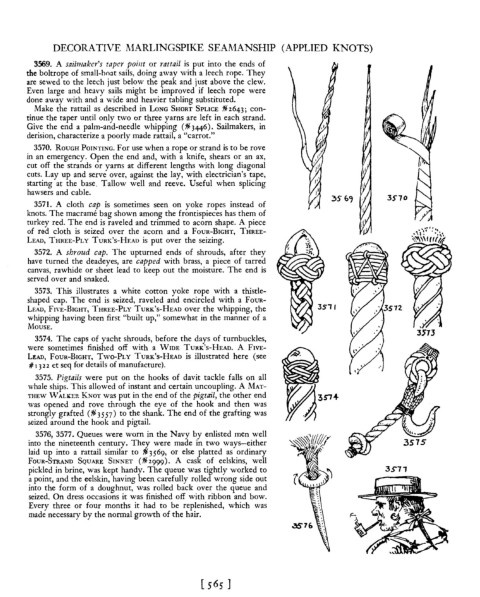Page 574 - The Ashley Book of Knots
P. 574
DECORA TIVE MARLINGSPIKE SEAMANSHIP (APPLIED KNOTS)
3569. A sail11lllkcr's taper poillt or rattail is put into the ends of
the boltrope of small-hoat sails, doing away with a leech rope. They
are sewed to the leech just below the peak and just above the clew.
Even large and heavy sails might be improved if leech rope were
done away with and a wide and heavier tabling substituted.
Make the rattail as described in LONG SHORT SPLICE ~ 2643; con-
tinue the taper until only two or three yarns are left in each strand.
Give the end a palm-and-needle whipping (~3446). Sailmakers, in
derision, characterize a poorly made rattail, a "carrot."
3570. ROUGH POINTING. For use when a rope or strand is to be rove
in an emergency. Open the end and, with a knife, shears or an ax,
cut off the strands or yarns at different lengths with long diagonal
cuts. Lay up and serve over, against the lay, with electrician's tape,
starting at the base. Tallow well and reeve. Useful when splicing
hawsers and cable.
356<) 3570
3571. A cloth cap is sometimes seen on yoke ropes instead of
knots. The macrame bag shown among the frontispieces has them of
turkey red. The end is raveled and trimmed to acorn shape. A piece
of red cloth is seized over the acorn and a FOUR-BIGHT, THREE-
LEAD, THREE-PLY TURK'S-HEAD is put over the seizing.
3572. A shroud cap. The upturned ends of shrouds, after they
have turned the deadeyes, are capped with brass, a piece of tarred
canvas, rawhide or sheet lead to keep out the moisture. The end is
served over and snaked.
3573. This illustrates a white cotton yoke rope with a thistle-
shaped cap. The end is seized, raveled and encircled with a FOUR- •
••
LEAD, FIYE-BIGHT, THREE-PLY TURK'S-HEAD over the whipping, the 351' 72 •
whipping having been first "built up," somewhat in the manner of a
MOUSE. ,
3J73
3574. The caps of yacht shrouds, before the days of turnbuckles,
were sometimes finished off with a WIDE TURK'S-HEAD. A FIVE-
LEAD, FOUR-BIGHT, TWO-PLY TURK'S-HEAD is illustrated here (see
# 1322 et seq for details of manufacture).
,
3575. Pigtails were put on the hooks of davit tackle falls on all
whale ships. This allowed of instant and certain uncoupling. A MAT-
THEW \\TALKER KNOT was put in the end of the pigttXil, the other end
was opened and rove through the eye of the hook and then was
strongly grafted (~35 57) to the shank. The end of the grafting was
seized around the hook and pigtail.
3576, 3577. Queues were worn in the Navy by enlisted men well
into the nineteenth century. were made in two ways-either 3575
laid up into a rattail similar to 3569, or else platted as ordinary
FOUR-STRAND SQUARE SINNET (~2999). A cask of eelskins, well
pickled in brine, was kept handy. The queue was tightly worked to 3S11
a point, and the eelskin, having been carefully rolled wrong side out
into the form of a doughnut, was rolled back over the queue and
seized. On dress occasions it was finished off with ribbon and bow.
Every three or four months it had to be replenished, which was
made necessary by the normal growth of the hair.

